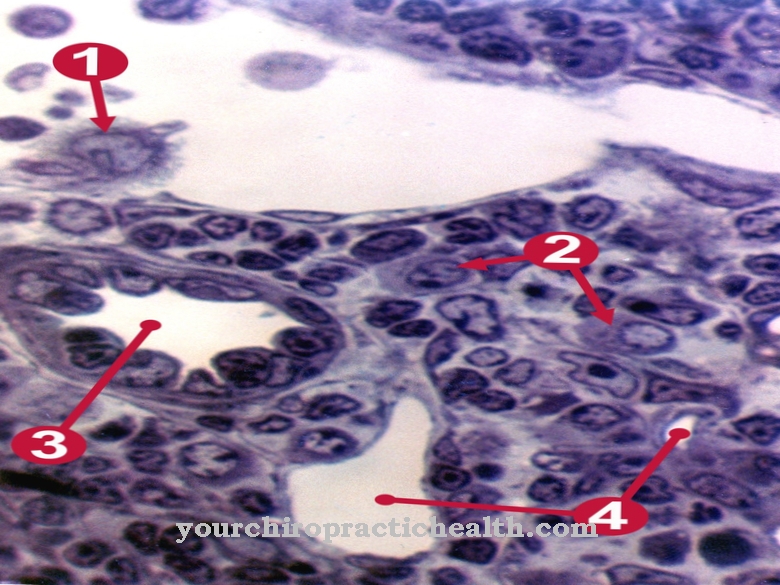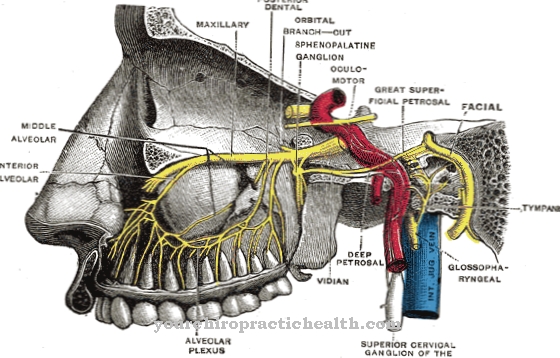The Schwann cells are a type of glial cell used in the peripheral nervous system to stabilize and nourish nerve fibers. They also wrap around the axons of myelinated nerve fibers, supplying them with insulating myelin. In inflammatory demyelinating diseases in the peripheral nervous system, the myelin of the cells is destroyed and neurological failures occur.
What is the Schwann cell?
The physician understands Schwann cells to be one of around ten special forms of glial cells. All glial cells are located in the nerve tissue. They take on elongations of up to 100 µm and surround the axon with nerve fibers. Schwann cells only cover peripheral nerve fibers.
In vertebrates, they even wrap themselves several times around the axon of a nerve cell. Like all other glial cells, Schwann cells primarily have supporting and insulating functions. The German physiologist and anatomist Theodor Schwann gave the cells their name in the 19th century. The Schwann supporting cells are exclusively a part of the peripheral nervous system and do not occur in the central nervous system. The same applies to the peripheral glial cell types of the mantle cells, the motor teloglia and the Müller cells.
The glial support cells of the central nervous system are to be differentiated from peripheral glial support cells such as Schwann cells. The neuroglia and radial glia, for example, fall into this group. The oligodendrocytes within the central nervous system fulfill exactly the same function as the Schwann cells in the peripheral nervous system. Unlike those in the central nervous system, the glial cells of the peripheral nervous system may be able to recover from injuries.
Anatomy & structure
Schwann cells mainly consist of cytoplasm and a cell nucleus. The nucleus and the cytoplasm of the Schwann cell are located in its outer area. This outer area is also called Neurolemm or Schwann's sheath. The so-called basal lamina is located around the neurolemm. This is a seemingly homogeneous layer of proteins that forms the basis of epithelial cells.
This basal lamina connects the neurolemm with the connective tissue of a surrounding nerve fiber. In the peripheral nervous system, the Schwann cells are extremely close to one another. However, there is always an interruption between two neighboring Schwann cells, which creates a saltatory conduction and serves to optimize conduction speeds. These interruptions are called Ranvier poker rings.
These poker rings are arranged at a distance of between 0.2 and 1.5 millimeters. The neurologist also calls the distance between the poker rings internode or internodal segment. Some interruptions in the myelin layer also run obliquely and are then referred to as so-called Schmidt-Lantermann notches.
Function & tasks
The Schwann cells in the peripheral nervous system take on support functions and stabilize nerves. Apart from that, like all other glial cells, they also feed the nerve fibers - in this case those of the peripheral nervous system. But these vital tasks are not your only ones. In addition to supporting and nutritional functions, they also have insulating functions in connection with myelinated fibers. They produce slices of insulating myelin.
The Schwann cells attach themselves to the axons of myelinated nerve fibers and, through the myelin generated in the process, quickly create conductive nerves. Myelin is a fatty protein substance that prevents electrical excitations from migrating. The bioelectrics of the nervous system would not function without insulating myelin, because the excitation potentials would ever dissolve into the vicinity of the nerve fibers. With the myelin, the Schwann cells also protect nerve lines from excitations that do not affect them. The isolation increases the capacity and conduction velocity of axons.
Glial cells thus ultimately ensure that the body's own stimulus transmissions run smoothly through the production of myelin. The smooth transmission of stimuli is essential for numerous bodily functions. For example, the body's reflexes would be inconceivable without rapidly conducting nerve fibers. The same applies to the processing of perception in the sensory system. If sensory perception via rapidly conducting nerve fibers did not quickly reach the brain, then any impression of one's own environment would be delayed.
In addition to the myelinated, fast-working fibers, the nervous system also encompasses non-myelinated, slower-working nerve fibers. These unmarked nerve fibers in turn supply the Schwann cells with cytoplasm.
You can find your medication here
➔ Medicines for paresthesia and circulatory disordersDiseases
In connection with the Schwann cells, demyelinating diseases in particular play a role. These diseases are also called demyelinating diseases in neurology and destroy the myelin of the nervous system. If several nerve cells are affected by demyelination, the MRI shows a focal image.
The most famous demyelinating disease is the inflammatory autoimmune disease multiple sclerosis. In this disease, the immune system mistakenly recognizes the body's own healthy tissue of the nervous system as a threat and attacks this tissue. This creates inflammation that destroys the myelin sheath of the nervous system. In the peripheral nervous system, this destruction corresponds to demolishing of the Schwann cells that wrap around the peripheral axons. Miller-Fisher syndrome is also an inflammatory demyelinating disease. It only affects the peripheral nervous system.
In addition to a lack of reflexes, symptomatic paralysis and movement disorders often occur. Other demyelinating diseases are Balo's disease, funicular myelosis, and neuromyelitis optica. In addition to demyelinating and inflammatory diseases, toxic processes can also damage or destroy myelin. After each demyelination, the transmission of stimuli is disturbed. Depending on how many axons are affected and where the affected axons are, neurologically more or less severe failures can occur. Injury to an axon or nerve fiber itself can also cause demyelination.




























.jpg)